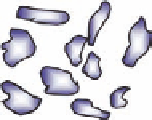Geoscience Reference
In-Depth Information
Raw material
Firing/Stintering/Treatment by
other methods
Hydrothermal
processing
Highly controlled diffusion, size and shape control, grain boundary
effect minimized, dense particles, higher crystallinity, phase purity.
Figure 10.5 The major differences in the products obtained by ball milling or sintering or
firing and hydrothermal methods
[1]
.
now raising at the rate of 15% annually and reach 370 billion dollars by 2010, and
as per National Science Foundation (NSF) prediction it would jump into a trillion
dollar industry by 2015.
Of all the ceramics, the PZT family of ceramics has been studied extensively
using the hydrothermal technique. From early 1980s, several thousands of
reports have appeared on the preparation of these ceramics. Thermodynamic cal-
culation and kinetics of these systems have been studied extensively
[4,5,28]
.
Several new variants/approaches in the processing of these electronic ceramics
have been reported to enhance the kinetics, to shorten the processing time, to
control the size and shape, to maintain the homogeneity of the phases, and to
achieve reproducibility. A great variety of precursors and also the solvents have
been attempted in the processing of these ceramics. Similarly, fine film forma-
tion of these ceramics on an appropriate substrate has been accomplished by
several workers
[29,30]
.
10.5 Hydrothermal Technology for Nanotechnology
The nanomaterials are known for their unique mechanical, chemical, physical, ther-
mal, electrical, optical, magnetic, and also specific surface area properties, which
in turn define them as nanostructures, nanoelectronics, nanophotonics, nanobiotech-
nology, and nanoanalytics. In the last one decade, a large variety of nanomaterials





